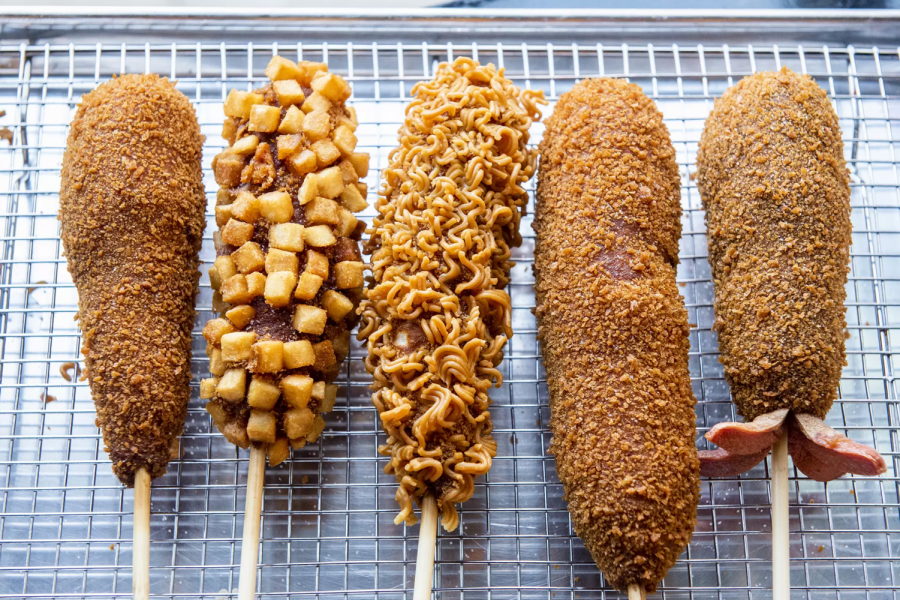Korean Twists on American Classics
April 29, 2020
Like any other cuisine, Korean cuisine is expansive. Older traditional foods focus on spice and making the food according to long-held traditions passed down from one generation to the next. It also includes the use of powders, pastes, and sauces like anchovy powder for soup, gochugaru or red pepper flakes for kimchi and tteokbokki, and soy sauce for marination in dishes like bulgogi. Garlic is also a commonly used spice, and I have eaten it raw in ssam, or meat and kimchi wrapped in vegetables, as well as cooked in commonly stir-fried dishes such as kimchi fried rice. But like any other East Asian cuisine, rice is a staple and it is integrated into many meals.
Yet, what if we took the spice-focused cuisine of Korea and combined it with something considerably American like pizza or a corn dog or a burger? Many chefs in Los Angeles and South Korea have been experimenting with such combinations for years, and thankfully, we live close enough to experience such new flavors. So let’s take a look at how these American foods have been “Koreanized”, and hopefully make your mouth water in the process.
Corn dogs are already great. The fried cornbread batter lends itself well to the sausage. But in Korea, chefs have taken it a step further and replaced the cornbread with a coating of rice flour. By doing so, it gives the corn dog a fried coating which has a texture similar to mochi. But this is only the first step, as while this version of the Korean hot dog is fine by itself, it has been further experimented with. Chefs have tried to integrate other items inside and outside these corn dogs. Some have half a sausage but it’s replaced with mozzarella or American cheese. Sometimes the rice flour batter is mixed with squid ink. The most noticeable combination I’ve seen is the batter being mixed with fries or even ramyeon noodles to give it another layer of crunch. Thankfully, you can stay local by ordering such delicious delights at Chung Chun which is on Baldwin Ave. here in Arcadia.
While the Korean hot dog has had a massive change both in the interior and exterior, foods like pizza, sandwiches, and burgers have mostly been changed by the type of meat that they contain. Instead of pepperoni or a normal lunchmeat, the meat is replaced by marinated Korean-style meat like bulgogi or in the case of the burger, which is marinated with Korean sauces. The soy sauce-based flavor may not seem like a huge difference on the surface, but it melts in your mouth more than one might expect. And though meat might be the biggest change, it’s far from the only one, as I’ve seen Korean pizzas with sweet potato filled crusts. The closest place which I can think of which has both bulgogi pizzas and sandwiches is Hot and Sweet Chicken on Huntington Drive here in Arcadia.
The last group of Korean mixed with American foods is quite unique, whether you consider it American or not. One of the first Korean fusions was Korean street tacos which were made in Koreatown here in LA to mix things up. These tacos are older in innovation than we high schoolers are, so I can’t possibly describe all the variations, but here are some common ones I’ve seen. Instead of carne asada or regular taco meat, the meat has sometimes been replaced with bulgogi, fried food, squid, or spicy meats. As for toppings, a mix of purple cabbage, lettuce, sliced bell peppers, and cilantro are common just as they are on regular tacos, but sometimes kimchi fried rice replaces Mexican rice. Other times green onions are even added. Tacos aren’t the only Mexican-American food to be experimented with either. Kimchi and bulgogi have also been added to burritos. And the aforementioned kimchi fried rice is sometimes added as well. These new creations have been quite popular, and there are a variety of places and food trucks in LA that can cater to your Korean taco or burrito needs. This Korean-Mexican mix of cuisine is also a distinctly American creation with a great background as one of the most prominent Korean-fusion chefs in the U.S., Roy Choi described that “the Korean taco was a phenomenon. … It just came out of us, we didn’t really think about it. The flavor, in a way, didn’t exist before, but it was a mash up of everything we had gone through.” Choi is well known for his Korean street tacos and it’s partially due to his influence that Korean fusion cuisine has risen to public recognition.
It seems as if for now this new category of food, Korean fusion, has no limit. I think we are lucky to live in Arcadia where we have direct access to all of these new foods and creations. So while we still live here and are still young, I encourage everyone to try these new hot dogs, burgers, and tacos for a new Korean twist on American classics.
Photo courtesy of BLOGTO.COM

